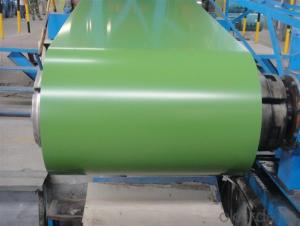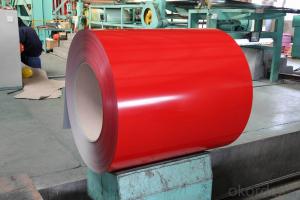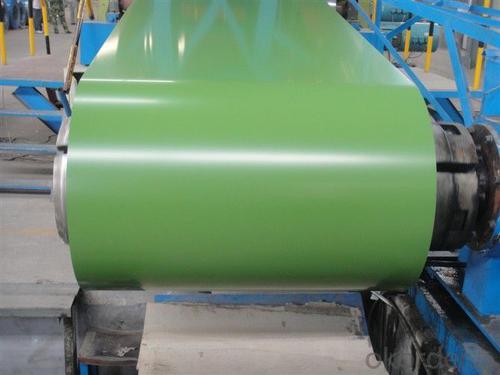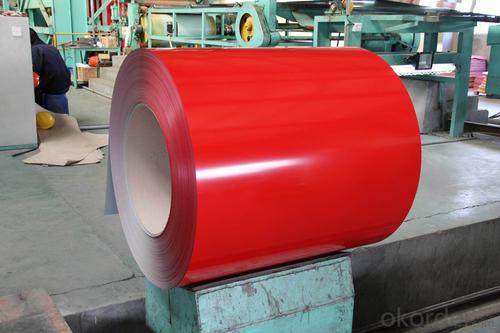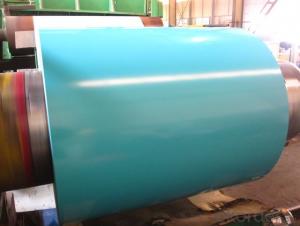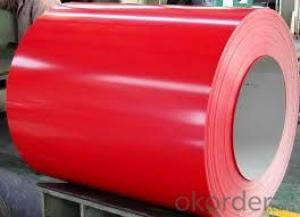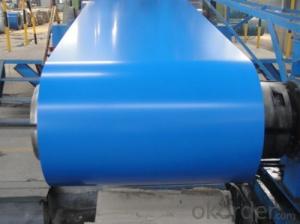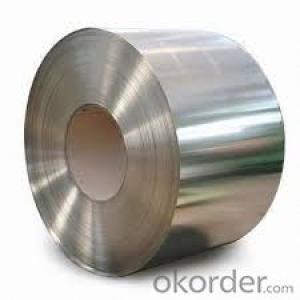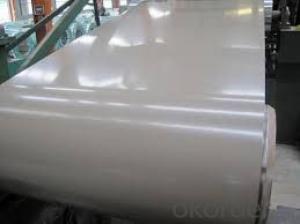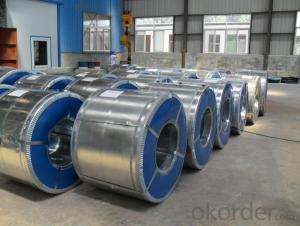Prepainted Hot Dipped Galvanized Steel Coils
- Loading Port:
- Shanghai
- Payment Terms:
- TT OR LC
- Min Order Qty:
- 60 m.t.
- Supply Capability:
- 5000 m.t./month
OKorder Service Pledge
OKorder Financial Service
You Might Also Like
1) AVAILABLE DESIGNATION OF (Prepainted galvanized steel coils) printed PPGI coils
Quality Q/BQB 440-2003 JIS G3312-1994 EN 10326-2004 ASTM A653-02a
EN 10327-2004 (BASE PLATE)
(BASE PLATE)
Commercial Steel TDC51D CGCC DX51D+Z/AZ CS Type A/B/C
Forming Steel (TSt01,TSt02,TSt03) CGCD1 FS Type A, Type B
Drawing TDC52D /TDC53D - DX52D+Z/AZ DDS TYPE A/C
Steel DX53D+Z/AZ
Structural TS280GD(TStE28) CGC400 S280D+Z/AZ SS275
Steel TS350GD(TStE34) CGC440 S350D+Z/AZ SS340 Class1
2) OUR SPECIFICATION OF (Prepainted galvanized steel coils) printed PPGI coils
Available Size:
Manufacturer Thickness Width Length of plate Inner diameter of coil
JIANGSU HUIYE STEEL SHEET CO.,LTD 0.2-1.2mm 800/914/1000/1200/1219/1250mm 1000-6000mm 508mm/610mm
Coated Mass OF (Prepainted galvanized steel coils) printed PPGI coils:
Base plate Available Coated Mass(g/m^2)
Galvanized Steel 80, 100, 120, 160, 180
Galvalume Steel 50, 70, 150
Available Painting OF (Prepainted galvanized steel coils) printed PPGI coils:
Category of Painting Item Code
Polyester PE
High-durability polyester HDP
Silicon modified polyesters SMP
Polyvinylidene fluoride PVDF
Easy-Cleaning —
Painting Thickness Top side: 20+5microns;
Bottom side: 5~7microns.
Color System Produce according to RAL Color System or as per buyer’s color sample.
Painting structure Top surface Bottom surface
Primer coating No coating 1/0
Primer coating Primer coating 1/1
Primer coating + Finish coating No coating 2/0
Primer coating + Finish coating Primer coating or single back coating 2/1
Primer coating + Finish coating Primer coating + Finish back coating 2/2
- Q: Molton is formed at 2800 F. Thats a fact. Now jet fuel at its hottest is 1800. Where does the other 1000 degress come in? And it was found at the WTC 7 site. Was this hit by a plane? A simple fire COULD NOT produce molton. This is a fact. Molton is formed during controlled demoliton of a building since all the bombs in the buiding go off and its very very hot. The fact there was MOLTON at the site is shocking to some since it is IMPOSSIBLE for molton to form from jet feul alone. Impossible. It needed another source. Now the claim that I'll get is that it weakened the stell but then we would find weak steel not molton. Why do you seem to throw this off of your shoulder? Do you not want to belive it? I'm no jet fuel guy but I know you cannot make molton by using just jet fuel. This is really proof that 9/11 was an inside job.
- I think there are things that you are missing here. First of all I looked up the MSDS sheet for Steel from US Steel. Steel is made of all kinds of different metals to start with and the melting/freezing point for steel is 1750 F not 2800 according to US Steel. In addition in the World Trade Center buildings there were all kinds of other materials that are normally used in construction that were all burning at the same time which would have added to the temperatures. Not only was it steel but it was iron, calcium and other building materials too. NIST provides a maximum gas temperature due to WTC fires of 1,000 °C: In no instance did NIST report that steel in the WTC towers melted due to the fires. The melting point of steel is about 1,500 degrees Celsius (2,800 degrees Fahrenheit). Normal building fires and hydrocarbon (e.g., jet fuel) fires generate temperatures up to about 1,100 degrees Celsius (2,000 degrees Fahrenheit). NIST reported maximum upper layer air temperatures of about 1,000 degrees Celsius (1,800 degrees Fahrenheit) in the WTC towers (for example, see NCSTAR 1, figure 6-36) Okay I don't know if you know who NIST is but that is the National Institute of Standards and Technology and they are some pretty smart people. They did not say that the steel melted due to the fires, but they did say that the temperatures surely did get high enough to to melt the steel. If US Steel says the melting point for steel is 1750 and NIST says that the temperatures were around 1800 F then that is high enough to melt the steel. I think the key is that there were other materials burning too.
- Q: What are the common quality control measures for steel coils?
- Some common quality control measures for steel coils include inspection for surface defects such as scratches, dents, or unevenness, checking for dimensional accuracy and thickness consistency, testing for mechanical properties such as tensile strength and hardness, conducting chemical composition analysis, and ensuring proper packaging and labeling of the coils.
- Q: What are the different types of steel coil processing equipment?
- In the manufacturing industry, various types of steel coil processing equipment are utilized. These equipment are specifically designed to handle and process steel coils in different ways, enabling efficient and precise production. Some commonly used steel coil processing equipment are as follows: 1. Decoilers: These machines are employed to unwind steel coils and feed them into the processing line. Equipped with motorized systems, they ensure a steady supply of material by controlling the unwinding process. 2. Straighteners: The purpose of straighteners is to flatten and straighten steel coils that may have become distorted during the coiling process. By utilizing a series of rollers, they eliminate any bends or waves, guaranteeing a smooth and consistent feed to the next processing stage. 3. Slitters: Slitters are responsible for cutting steel coils into narrower strips, allowing the production of various widths of steel sheets or strips. They consist of multiple sets of adjustable circular blades used to achieve the desired width. 4. Levelers: Levelers are utilized to correct any surface imperfections in steel coils, such as wavy or undulating surfaces. By means of a series of rollers, they apply pressure and reshape the material, resulting in a flat and uniform surface. 5. Shears: Shears are used to precisely cut steel coils into specific lengths. They can be either hydraulic or mechanical and are designed to provide clean and accurate cuts, ensuring the desired dimensions are achieved. 6. Recoilers: Recoilers are essential for rewinding processed steel coils back into tightly wound coils. They can be either motorized or manual and are crucial for storage and transportation purposes. 7. Edge trimmers: These machines are employed to remove any excess material from the edges of steel coils. By ensuring a clean and consistent edge, they enable better handling and further processing. 8. Coil cars: Coil cars are utilized for the transportation of steel coils within the processing facility. They are equipped with hydraulic or mechanical systems, facilitating easy loading and unloading of coils onto other equipment. These represent only a few examples of the diverse range of steel coil processing equipment used in the industry. Each piece of equipment plays a vital role in the manufacturing process, ensuring the efficient production of high-quality steel products.
- Q: How are steel coils processed for cutting to length or blanking?
- Steel coils are typically processed for cutting to length or blanking through a series of steps. First, the coils are unwound using a machine called an uncoiler, which feeds the steel into the cutting process. Then, the steel passes through a leveler to ensure a flat surface. Next, it enters a shear or blanking process, where the steel is cut into desired lengths or shapes. Finally, the cut pieces are stacked or packaged for further use or distribution.
- Q: What are the pros and cons to selecting a graphite shaft sand wedge over steel shaft?
- Graphite Shaft Wedges
- Q: What are the different methods of storing steel coils?
- There are several different methods of storing steel coils, including vertical stacking, horizontal stacking, eye-to-the-sky stacking, and interlocking stacking. Each method has its own advantages and considerations based on factors such as space availability, weight distribution, and accessibility for transportation and handling. Ultimately, the choice of storage method depends on the specific requirements and constraints of the steel coil storage facility.
- Q: Can steel coils be used in corrosive environments?
- Yes, steel coils can be used in corrosive environments. However, it is important to select the appropriate type of steel and implement suitable protective measures such as coatings or galvanization to prevent corrosion.
- Q: case hardening steel is adviced or thru hardening steel is most suitable?
- I don't know your application, but here is some advice. Case hard provides a hard shell around soft steel, depending on the bake, the case is usually .002-.008 thick. (thousands of an inch) Heat treated steel or tool steel is hard all the way thru. Case hardening, provides toughness with flexibility, however, once it's compromised, the part is scrap. Hardend tool steel is extreemly hard throughout and the harder it is, the more brittle it becomes. The application of the part will help you to determine the material needed. For instance; Plastic injection molds are very hard so the hot plastic wont erode them over years of use. Punch Press dies aren't as hard but are tougher to withstand the shock. Machine bolts are case hardened so they can last, but soft enough to allow some stretching during tightening. Either way, the time in mfg will be about the same. Most tool steels today cut like cheese, but take time to be heat treated. Tool steel will cost a bit more than low carbon steel. Low carbon steel is as machinable, and cheaper, but, again, the baking period is as long or longer than tool steel. There are a lot of materials on the market today that maintain the durability of heatreated steel without having to go thru that process. 4140, ( or chrome/moly) comes to mind. There are also some 400 series stainless that work as well, and others. You need to determine strength, flexibility, ease of mfg, cost and repairability when considering which steel to use.
- Q: How are steel coils used in the production of metal ductwork?
- The production of metal ductwork relies heavily on steel coils. Typically constructed from high-quality steel, these coils serve as the primary raw material for manufacturing ductwork. To begin the process, the steel coil is unwound and then cut into specific lengths based on the required dimensions of the ductwork. These lengths are then shaped using specialized machinery, such as roll formers or bending machines, to achieve the desired form. The steel coils are essential in providing the necessary strength and durability to the ductwork, ensuring its ability to withstand the pressure and environmental conditions it may encounter during operation. Additionally, the composition of the coil allows for easy fabrication and customization, enabling manufacturers to produce ductwork in various shapes and sizes to meet specific project requirements. Moreover, steel possesses inherent properties that make it an ideal material for ductwork. Its resistance to corrosion and fire makes it highly desirable. Steel coils can also be coated with protective layers, such as galvanized or stainless steel finishes, to further enhance their longevity and performance. This added protection ensures that the ductwork remains intact and functional, even in harsh environments or when exposed to corrosive substances. In conclusion, steel coils are indispensable in the production of metal ductwork as they provide the necessary raw material for fabrication. Their strength, durability, and customization capabilities make them a crucial component in the manufacturing process, resulting in reliable and long-lasting ductwork systems.
- Q: What are the different types of steel grades used for coil production?
- There are several types of steel grades used for coil production, including carbon steel, stainless steel, and alloy steel. Carbon steel is the most common type and is widely used due to its affordability and versatility. Stainless steel is highly resistant to corrosion and is often used in applications where hygiene and appearance are important. Alloy steel, on the other hand, contains additional elements such as manganese, nickel, and chromium, which enhance its strength and durability. Each type of steel grade has its own unique properties and is chosen based on the specific requirements of the coil production process.
Send your message to us
Prepainted Hot Dipped Galvanized Steel Coils
- Loading Port:
- Shanghai
- Payment Terms:
- TT OR LC
- Min Order Qty:
- 60 m.t.
- Supply Capability:
- 5000 m.t./month
OKorder Service Pledge
OKorder Financial Service
Similar products
Hot products
Hot Searches
Related keywords
